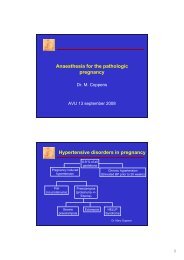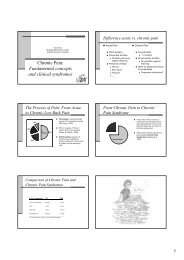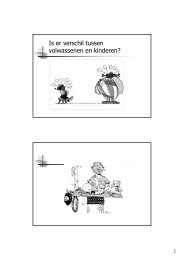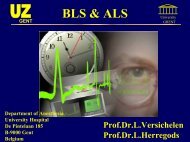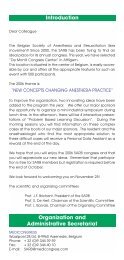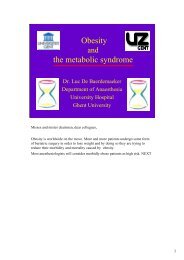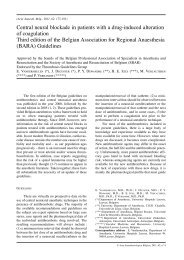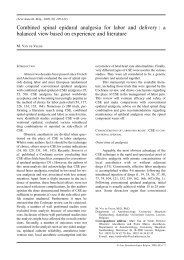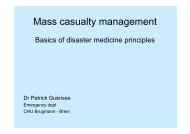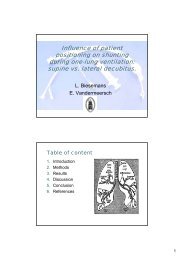Regional Anesthesia is Better than General Anesthesia
Regional Anesthesia is Better than General Anesthesia
Regional Anesthesia is Better than General Anesthesia
You also want an ePaper? Increase the reach of your titles
YUMPU automatically turns print PDFs into web optimized ePapers that Google loves.
<strong>Regional</strong> <strong>Anesthesia</strong> <strong>is</strong> <strong>Better</strong> <strong>than</strong><br />
<strong>General</strong> <strong>Anesthesia</strong><br />
Professor of Anesthesiology and Intensive Care<br />
Medicine<br />
Chair and Head of Department<br />
Department of <strong>Anesthesia</strong> and Intensive Care<br />
Medicine<br />
Lapeyronie University Hospital<br />
Montpellier - France
What should we speak about?<br />
• <strong>Regional</strong> anesthesia for the peroperative period :<br />
- Quality of <strong>Anesthesia</strong><br />
- Quality of postoperative analgesia<br />
- Cost effectiveness<br />
- Adverse events
Pain d<strong>is</strong>orders in the<br />
postoperative period<br />
Scores EVA<br />
7<br />
6<br />
5<br />
4<br />
3<br />
2<br />
1<br />
0<br />
J1 J2 J3 J4 J5 J6 J7 J8<br />
Jours postopératoires<br />
Vial et al. Ann Fr Anesth Réanim 2000
35<br />
30<br />
25<br />
20<br />
15<br />
10<br />
5<br />
0<br />
Pain symptoms at 24h<br />
Pain<br />
Hoarseness<br />
Sore throat<br />
Nausea<br />
Headache<br />
Chung. Anesth Analg 1995;80:896-902<br />
Faintness<br />
% of patients
Some aspects of functional impact of<br />
Ambulatory surgery<br />
D 1 D 2 D 7<br />
Painful patients (n) 80 70 54<br />
Troubles for (%)<br />
Activity level 73 61 50<br />
Walk 69 49 38<br />
Work 81 68 47<br />
Mood 22 23 15<br />
Relational 21 20 9<br />
Sleep 47 34 24<br />
Concentration 38 20 13<br />
Beauregard et al. Can J Anaesth 1998;45:304-11.
Potential Benefits of RA vs GA in Day Surgery<br />
Advantages to patients<br />
Improved quality of recovery<br />
less postoperative pain<br />
less postoperative nausea and vomiting<br />
•able to observe the procedure<br />
•communication with surgeon during procedure<br />
•an option to receive no, light or heavy sedation<br />
•earlier mobil<strong>is</strong>ation<br />
Advantages to Surgeon and staff<br />
assessment of function before wound closure<br />
possible to d<strong>is</strong>cuss treatment options with patient<br />
"fast tracking", i.e. by-passing phase I recovery room<br />
shortened recovery time<br />
less requirements in PACU/Phase II recovery room<br />
fewer unanticipated overnight adm<strong>is</strong>sions
Strategies for success with RA in Day Surgery<br />
surgeon should d<strong>is</strong>cuss with initial patient v<strong>is</strong>it that RA <strong>is</strong> an option<br />
assessment at preanaesthesia clinic<br />
d<strong>is</strong>cuss benefits of RA<br />
d<strong>is</strong>cuss different options for sedation/MAC*<br />
d<strong>is</strong>cuss treatment of possible pain after the block wears off<br />
printed information for patients<br />
instructional videos helpful<br />
red<strong>is</strong>cussion of RA on the day of operation<br />
anaesthesiolog<strong>is</strong>t should be interested and skilled with blocks they are us<br />
MAC = monitored anaesthesia care
Optim<strong>is</strong>ing spinal anaesthesia for Day Surgery.*<br />
bupivacaine 7.5 mg usually appropriate<br />
small doses are not long acting<br />
concentration <strong>is</strong> related to duration and recovery<br />
hyperbaric bupivacaine slower acting <strong>than</strong> hypobaric<br />
adrenaline (epinephrine) not recommended<br />
prolongs recovery<br />
intrathecal fentanyl recommended<br />
prolongs anaesthesia but not recovery
Small-dose selective spinal anesthesia for short-duration outpatient laparoscopy :<br />
recovery character<strong>is</strong>tics<br />
P Lennox Anesth Analg 2002 Spinal : lidocaine 1% 10 mg +10µg sufentanil vs GA :<br />
Desflurane<br />
60<br />
50<br />
Spinal<br />
Desflurane<br />
% of<br />
patients<br />
40<br />
30<br />
Minutes<br />
20<br />
10<br />
0<br />
Extubation<br />
Straight leg ra<strong>is</strong>e<br />
Ambulate<br />
Postoperative pain
Small-dose selective spinal anesthesia for short-duration outpatient laparoscopy :<br />
Pharmacoeconomic compar<strong>is</strong>on<br />
Spinal : lidocaine 1% 10 mg +10µg sufentanil vs GA : Desflurane<br />
P Lennox Anesth Analg 2002<br />
120<br />
$ Can<br />
100<br />
Spinal<br />
Desflurane<br />
80<br />
60<br />
40<br />
20<br />
0<br />
<strong>Anesthesia</strong> supplies<br />
Drugs<br />
Nursing time<br />
Total
Outpatient Orthopedic Procedures<br />
60<br />
50<br />
40<br />
30<br />
% of patients with<br />
significant pain<br />
H24<br />
Day 7<br />
Klein Anesth Analg 2002<br />
Grant Reg Anest Pain Med 2001<br />
Chung Anesth Analg 1997<br />
Chung Can J Anaesth 1996<br />
20<br />
10<br />
0<br />
Sciatic Block<br />
Fe m oral Block<br />
Lumbar Ple xus<br />
Sciatic Block<br />
Fe m oral Block<br />
Lumbar Ple xus<br />
Some RA<br />
Without RA
Use of different RA techniques for Day Surgery in USA<br />
Technique<br />
% of DSU using th<strong>is</strong> block<br />
IVRA 80<br />
Axillary block 75<br />
Spinal<br />
72<br />
Epidural 64<br />
Ankle block 55<br />
Interscalene 42<br />
Intercostal block 29<br />
Femoral block 19<br />
Elbow block 18<br />
Sciatic block 12<br />
Popliteal 8
Why are the anesthet<strong>is</strong>ts not agree with the regional<br />
anesthesia techniques?<br />
Unfamiliarity with the techniques<br />
No advantage to the technique over standard methods<br />
Surgical preference<br />
Toxicity of the local anesthetic<br />
Unfamiliarity with the techniques<br />
Inability for patients to care for themselves<br />
Patient injury (i.e. fall, accidental limb or nerve trauma)<br />
Preparation time/log<strong>is</strong>tics<br />
Onset time<br />
Percent<br />
0 10 20 30 40 50 60<br />
S. Klein et al. A&A 2002
End of regional block<br />
Is it really a problem?<br />
3<br />
2,5<br />
2<br />
Hospital<br />
At home day 0<br />
t home day 1<br />
*<br />
*<br />
*<br />
1,5<br />
1<br />
0,5<br />
0<br />
No RA Caudal block Infiltration Ilioinguinal<br />
block<br />
Kokinsky et al. Paediatric Anaesthesia 1999
Outpatient Orthopedic Procedures<br />
Arthroscopic ACL Repair Mulroy Reg Anesth Pain Med 2001<br />
45<br />
VAS<br />
Sham Block<br />
40<br />
0.25% Bupi<br />
35<br />
0.5% Bupi<br />
30<br />
25<br />
20<br />
15<br />
10<br />
5<br />
0
Wang Reg Anesth Pain Med<br />
2002<br />
Total knee arthroplasties<br />
30 patients<br />
Hospital stay :<br />
• 3 days with FNB<br />
• 4 days with<br />
Saline
Femoral-sciatic nerve blocks for complex<br />
outpatient knee surgery…<br />
Williams BA et al, Anesthesiology 2003,98:1206-13<br />
Less invasive surgery<br />
• Evaluation during<br />
anesthesia/manipulation<br />
• Knee arthroscopy with<br />
–Debridement<br />
–Lateral retinacular release<br />
–Men<strong>is</strong>cal surgery/repair<br />
–Removal of superfical hardware<br />
–Allograft ACL reconstruction<br />
More complex surgery<br />
• High tibial osteotomy<br />
• Knee arthroscopy with<br />
–ACL with patellar tendon or<br />
hamstring autograft<br />
–ACL and/or ligament<br />
reconstruction<br />
–Men<strong>is</strong>cal reconstruction
Femoral-sciatic nerve blocks for complex<br />
outpatient knee surgery…<br />
Williams BA et al, Anesthesiology 2003,98:1206-13<br />
40<br />
30<br />
Percent of patients<br />
No FNB<br />
FNB/FSNB<br />
20<br />
10<br />
0<br />
less<br />
invasive<br />
more<br />
invasive<br />
less<br />
invasive<br />
more<br />
invasive<br />
less<br />
invasive<br />
more<br />
invasive<br />
Pain in PACU Pain in SDRU UHA
A compar<strong>is</strong>on of infraclavicular nerve block versus general anesthesia for hand and wr<strong>is</strong>t<br />
day-case surgeries<br />
A Hadzic Anesthesiology 2004 40 mL of 2-chloroprocaine + propofol sedation vs propofolfentanyl<br />
GA Min<br />
90<br />
80<br />
70<br />
Infraclavicular block<br />
GA<br />
60<br />
50<br />
40<br />
30<br />
20<br />
10<br />
0<br />
OR time<br />
Induction time<br />
Preparation<br />
Surgery
A compar<strong>is</strong>on of infraclavicular nerve block versus general anesthesia for hand and wr<strong>is</strong>t<br />
day-case surgeries<br />
A Hadzic Anesthesiology 2004 40 mL of 2-chloroprocaine + propofol sedation vs propofolfentanyl<br />
250GA<br />
Infraclavicular block<br />
GA<br />
200<br />
Minutess<br />
150<br />
100<br />
% of patients<br />
50<br />
0<br />
Fluid intake<br />
Solid Intake<br />
Ambulatio<br />
Home readiness<br />
D<strong>is</strong>charge<br />
No pain at 72 h<br />
No medication at 72 h
Fast-tracking after outpatient laparoscopy : reasons for failure after propofol, sevoflurane<br />
and desflurane anesthesia<br />
M Coloma Anesth Analg 2001 Reasons patients did not bypass the postanesthetic<br />
care unit<br />
60<br />
Propofol Sevoflurane Desflurane<br />
50<br />
40<br />
30<br />
20<br />
10<br />
0<br />
Residual sedation Non Specific factors surgical complication no bed available
Process Analys<strong>is</strong> in Outpatient Knee Surgery : Effects of regional and general<br />
anesthesia on anesthesia-controlled<br />
Cruciate ligament<br />
time<br />
repair , induction rooms , one<br />
B Williams Anesthesiology 2000 anesthet<strong>is</strong>t and two nurses<br />
Parameter<br />
GA<br />
GA/RA<br />
RA<br />
Holding<br />
area time<br />
39 min<br />
33 min<br />
37 min<br />
Anesthesi<br />
a<br />
preparatio<br />
D<strong>is</strong>charge ntime<br />
time<br />
Nursing<br />
interventio<br />
Incidence ns<br />
of pain<br />
11 min<br />
246 min<br />
2.4<br />
63%*<br />
16 min<br />
238 min<br />
1<br />
23%<br />
17 min*<br />
234 min<br />
0.4*<br />
14%<br />
Incidence<br />
of PONV<br />
39%*<br />
34%<br />
9%
Economics of nerve block pain management after anterior cruciate ligament repair :<br />
Potential hospital cost savings via associated postanesthesia care unit bypass and<br />
same day d<strong>is</strong>charge<br />
B Williams Anesthesiology 2004<br />
100<br />
90<br />
80<br />
70<br />
60<br />
GA without NB<br />
GA with NB<br />
Neuraxial without NB<br />
Neuraxial with NB<br />
lower extremity NB<br />
Scenario<br />
Traditional<br />
care GA<br />
Nerve block<br />
Scenario<br />
PACU costs<br />
105000<br />
18900<br />
Hospital<br />
adm<strong>is</strong>sion<br />
costs<br />
16363<br />
3850<br />
Total costs<br />
996363<br />
897750<br />
50<br />
Saving with<br />
nerve block<br />
86100<br />
12513<br />
98613<br />
40<br />
30<br />
20<br />
10<br />
0<br />
PACU<br />
bypassed<br />
Nurse Int for<br />
pain<br />
Nurse int for<br />
PONV<br />
Adm<strong>is</strong>sion<br />
preapproved<br />
Adm<strong>is</strong>sion<br />
unplanned
Compar<strong>is</strong>on of the costs and recovery profiles of three anesthetic techniques for<br />
ambulatory anorectal surgery<br />
S Li Anesthesiology 2000<br />
Intraoperative<br />
costs<br />
70<br />
Recovery costs<br />
60<br />
Local anesthesia<br />
with sedation<br />
Local<br />
Spinal<br />
GA<br />
63±21<br />
5±2<br />
Spinal<br />
anesthesia<br />
83±15<br />
21±9<br />
<strong>General</strong><br />
<strong>Anesthesia</strong><br />
125±21<br />
19±9<br />
Perioperative 50<br />
costs<br />
40<br />
Duration of<br />
anesthesia<br />
30<br />
Time to oral<br />
intake 20<br />
69±20<br />
40±15<br />
12±5<br />
103±19<br />
72±17<br />
59±18<br />
145±25<br />
75±19<br />
60±30<br />
Time to Aldrete<br />
10<br />
score of 10<br />
0<br />
19±7<br />
30±19<br />
Time to 0home-<br />
readiness<br />
76±17<br />
193±112<br />
Hypotension Pain Nausea Highly sat<strong>is</strong>fied Sat<strong>is</strong>fied<br />
171±58<br />
Duration of<br />
hospital stay<br />
116±21<br />
266±112<br />
247±65
Global costs for ambulatory orthopedic surgical procedures<br />
Macaire Miner Anesth 2002<br />
Hallux valgus<br />
Classical<br />
RA±GA<br />
Ambulatory +<br />
nurse network<br />
Decrease of<br />
costs<br />
CHU Montpellier 2133 € 484 + 108 € 72 %<br />
Clinique Lyon 1352 € 635 + 108 € 45 %<br />
Rotator cuff<br />
repair<br />
CHU Montpellier 2841 € 1426 +103 € 46 %<br />
Clinique Lyon 1352 € 1052 + 150 € 15 %
Continuous peripheral nerve blocks<br />
- Compar<strong>is</strong>on of costs versus GA.<br />
• <strong>Regional</strong> anesthesia doesn’t have influence on the duration of the surgical<br />
procedureand doesn’t increase the duration of operating room and PACU<br />
patient’s stay Dexter Reg Anesth Pain Med 1998, Anesth Analg 1995<br />
• For an ambulatory surgery the hospital stay <strong>is</strong> two times longer with a GA<br />
<strong>than</strong> with an Axillary Allen Anesthesiology 1993<br />
• Continuous peripheral nerve blocks decrease the overall costs for upper<br />
limb surgery ( 4780 vs 3546 $) , hospital stay and complications Horn<br />
Anesthesiology 2000,2001,2002<br />
•For lower limb procedures , peripheral nerve blocks decrease the global<br />
costs , the amount of patients readm<strong>is</strong>sions and increase the surgical<br />
success Nakamura Arthroscopy 1997, Mulroy Reg Anesth Pain Med 2001,Williams<br />
Anesthesiology 2003
Study WMD Weight 95% CI<br />
Rademaker 94 10,4<br />
Pasqualucci 94 8,9<br />
Jor<strong>is</strong> 95 9,1<br />
Raetzell 95 5,5<br />
Scheinin 95 11,1<br />
Pasqualucci 96 11<br />
Szem 96 11,5<br />
Furher 96 11,3<br />
Mraovic 97 10,5<br />
Tsimoyiann<strong>is</strong> 98 10,7<br />
Total (95%CI) 100 -13[-20;-6]<br />
Intraperitoneal LA for<br />
cholecystectomy<br />
vs control<br />
Moiniche et al. A&A 2000
Mesosalpinx / fallopian tube block vs control<br />
Moiniche et al. A&A 2000<br />
Study WMD Poids 95% CI<br />
Alexander 87 18,5<br />
Baram 90 10,7<br />
Smith 91 15<br />
Barclay 94 9,2<br />
Wheatley 94 19,5<br />
Ezek 95 12,8<br />
Fiddes 96 14,3<br />
Total (95%CI) 100 -19[-25;-14]
Study WMD Weight 95% CI<br />
Smith 91 15<br />
Hendersen 90 10,6<br />
Smith 92 8,3<br />
Joshi 93 2,8<br />
Richmond 94 3,9<br />
Moiniche et al.<br />
Karlsson 95 8,6<br />
Systematic review<br />
Boden 94 6,7<br />
Intra-articular LA<br />
Björsson 94 3,9 Reg Anesth 1999<br />
Chan 95 7,6<br />
Shaw 95 9,2<br />
Cepeda 97 15<br />
Richardson 97 8,4<br />
Total 100 -10,5 [-13,8;-7,3]
What are really the<br />
reasons for not<br />
using RA ?<br />
Unqualified!!



